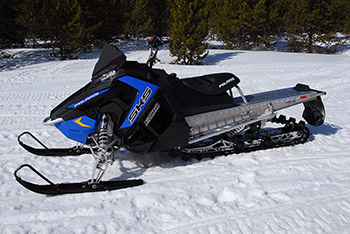The name Snow King Special or SKS defined Polaris’s ultimate long-tracked sleds a couple of decades ago. Then things got very serious and the Rocky Mountain King (RMK) name became the company’s definitive handle for mountain riders.
For 2016 the SKS is front and center again with all the sizzle of Polaris’s ultimate mountain sled, the Pro RMK, now using the fresh AXYS front clip and low mounted 800HO engine introduced last year.
The main difference between the two is the SKS does not utilize the lighter belt-drive Quick-Drive system you get with the Pro RMK. This is a clue to the market the SKS is targeted at.
Although the belt final drive is lighter, there are less gearing combos available than with a conventional chain case. This drive benefit makes the SKS appealing to a wider range of freeride and pure mountain users without sacrificing much in the way of performance.
As it is, the 2016 AXYS-based Polaris mountain sleds have dropped considerable weight compared to the last RMK version and feature some critical ergonomic and balance changes that make them incredible deep snow performers.
The SKS and the Pro RMK use the new forged aluminum upper and lower A-arms – actually the first production mountain sleds to ever go this far, and the 3-lb lighter redesigned mountain skidframe with Swiss Cheese rails that have been computer designed for efficiency.
Taller spindles are used and overall more ground clearance is available so the sled slithers through powder with less resistance and digs out of powder much quicker. There’s an extra bulkhead cooler added to the SKS so it can handle more sparse or frozen-down snow conditions and longer riders to your fave powder playground.
The SKS comes with a choice of three tracks in 155-inch lengths. There’s a 2.4-incher or a 2.6 (Series 6) or a Peak 2.25, ideal for freeriding. Unlike the Pro-RMK, the SKS uses piggyback Walker-Evans clickers up front and has extra idlers in the skidframe to take advantage of the varying snow conditions it’s designed to be used in.
Our mountain test riders were very impressed with this sled and felt it could climb nearly everywhere an RMK could go, turns extremely well in off-camber situations and was very maneuverable in powder or when side-hilling.
Any weight handicap (compared to the super-light RMK) was masked thoroughly by the sled’s balance and agility in a wider assortment of riding situations. Keep in mind, this sled is probably close to the same weight as last year’s Pro-RMK but has all the AXYS features of the new-generation platform.



